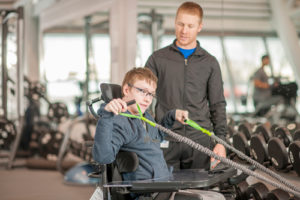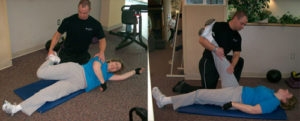 Physical therapy is often the first step in treating cerebral palsy. It can help improve motor skills and can prevent movement problems from getting worse over time. Physical therapy implements strength and flexibility exercises, heat treatment, massages and special equipment to give individuals with cerebral palsy more independence, as reported by the Cerebral Palsy Guide.
Physical therapy is often the first step in treating cerebral palsy. It can help improve motor skills and can prevent movement problems from getting worse over time. Physical therapy implements strength and flexibility exercises, heat treatment, massages and special equipment to give individuals with cerebral palsy more independence, as reported by the Cerebral Palsy Guide.
The extent to which physical therapy helps depends on the severity and type of each case of cerebral palsy. Individuals with milder cases of CP may only require some physical therapy to treat their condition. In more severe cases, it may be used alongside other treatments or medications. Beginning physical therapy as early as possible usually gives them the best chances at improvement.
Many individuals with CP live highly functional lives as adults. Many have careers and families. In adulthood, people with CP often focus on pain management, conserving energy, adaptive equipment, and environment modifications to promote independence at work and at home. Physical therapists can help with managing these concerns. Like many adults, individuals with CP have muscle and joint pain in adulthood. Physical therapists can prescribe an exercise routine that enables the individual to stay strong and minimize joint issues.
Physical therapists are skilled in all of these areas, and they partner with people with CP and their caregivers to address their individual goals for realistic, positive outcomes. There are many benefits of physical therapy, from improving mobility to preventing future issues such as contractures and joint dislocations by keeping the body strong and flexible. Many children and adults with CP increase their level of self-reliance through physical therapy.
The main goal of physical therapy is to make everyday movements easier for people with cerebral palsy.
 Physical therapy can improve Coordination, Balance, Strength, Flexibility, Endurance, Pain management, Posture, Gait, and overall health.
Physical therapy can improve Coordination, Balance, Strength, Flexibility, Endurance, Pain management, Posture, Gait, and overall health.
The types of exercises used to vary and have specific benefits for each type of cerebral palsy.
Benefits of cerebral palsy type include:
- Spastic – Physical therapy can reduce the muscle tension and jerky movements associated with spastic cerebral palsy. Exercises such as stretching can even relieve stiffness over time.
- Athetoid – People with athetoid cerebral palsy use physical therapy to increase muscle tone and gain more control over their movements.
- Ataxic – There are exercises that can improve balance problems faced by those with ataxic cerebral palsy.
Physical therapists also tailor treatment based on the location of movement issues. Movement issues in children with cerebral palsy can be limited to one half of the body (hemiplegia), the legs (diplegia) or in the torso and all four limbs (quadriplegia). Therapists prescribe special exercises and routines for hemiplegia, diplegia, and quadriplegia that may help the child regain movement in the affected area over time.
Physical therapy can also treat a range of other issues experienced by children and adults with CP, including:
– Scoliosis – an abnormal curvature in the spine, common in up to 30 percent of children with cerebral palsy.
– Thoracic kyphosis – a contortion of the upper spine.
– Lumbar lordosis – a contortion of the lower spine.
– Pelvic inclination – a protrusion of the pelvis either in the front or rear.
– Pelvic rotation – a horizontal contortion of the pelvis.
– Pelvic obliquity – a contortion of the pelvis at an angle.
– Knee deformity – abnormally straight or bent knees that may be caused by pelvic deformities.
– Shortened Achilles tendon – a shortened tendon that causes issues with walking and standing.
– Hand and wrist deformities – abnormal flexing in the hand and wrist that prevents the development of fine motor skills.
For more info visit: www.cardioflextherapy.com
